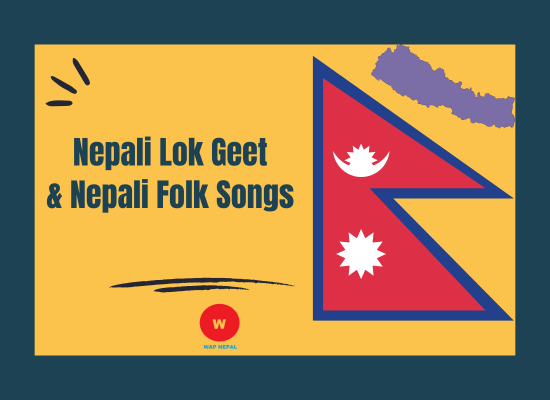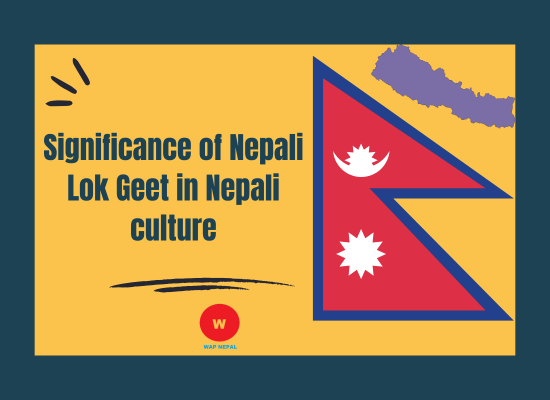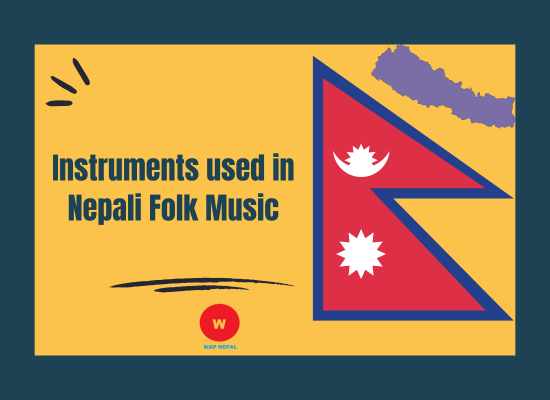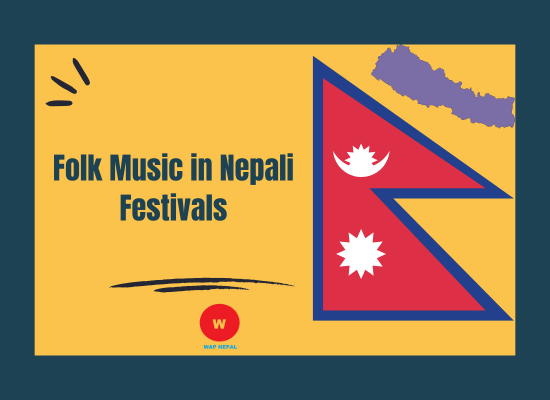Music is integral to every culture, and Nepal is no exception. In Nepal, one of the most prominent genres of music is Nepali Lok Geet, which translates to “folk songs” in English. These traditional folk songs hold great cultural significance and are a means to preserve and promote Nepal’s rich heritage and diversity.
Nepali Lok Geet is the true heritage of Nepal. They are composed with authentic touch to our Nepali culture and society. They comprise romanticism too, but they are unlike any other genres. They are composed of folk music with instruments like Sarangi, Madal, Tabala, and Flute. However, with time other modern instruments like Guitars, Keyboards are also being used, but they haven’t lost their identity yet.

Nepali lok songs are different than Nepali Pop Songs in Nepali music industry. Nepali folk songs have different kinds of craze among Nepalese.
Table of Contents
What is Nepali Lok Geet and its significance in Nepali culture?
Nepali Lok Geet refers to the traditional folk songs sung in the local tunes of different regions, reflecting the unique cultural identity of each community and part of Nepal. These songs are deeply rooted in the historical and social fabric of the country and have been passed down through generations. The importance of folk songs in Nepali culture cannot be overstated as they celebrate various aspects of life, such as festivals, love, spirituality, and daily activities.
Nepali Lok Geet is distinctively different from other genres of music in Nepal. While modern genres often incorporate influences from various international music styles, folk songs remain deeply connected to the traditional musical heritage of the country. The lyrics, melodies, and rhythms of folk songs reflect the cultural traditions and values of Nepali society.

Nepali Lok Geet is leading in trends, and they even beat other genres when it comes to the Nepali market. They are preferred by people of all age groups, and everybody just finds their feet moving, body shaking when lok geet catches their ears. Based on artists and situations, various other forms of lok geet have been introduced, and these days, lok geet has also been fused with pop style making it lok-pop. Shiva Pariyar, Ramji Khand, and Pashupati Sharma are some of the artists in trend, and they have given a number of hits. Meanwhile, Lok Geets are attracting lots of Nepali youths too.
Top 10 Nepali Lok Geet and their cultural significance
There are numerous exceptional folk songs in Nepal, but here are the top 10 Nepali Lok Geet that have gained immense popularity over the years: Nepali folk songs are categorized into various genres, each with its distinct characteristics:
Dohori:
Dohori is a unique form of folk song in Nepal where two teams, usually male and female, engage in a lyrical conversation. It is a popular type of folk music performed during social gatherings and festive occasions. Dohori songs often touch upon various social issues, love, and satire.
Dohori songs involve a lyrical conversation between two teams. These songs often have social and emotional themes and provide a platform for expressing opinions and engaging in light-hearted banter.
Teej Song:
Teej is a widely celebrated festival in Nepal, and Teej songs are an essential part of the festivities. Women primarily sing these songs and express their joys, sorrows, and aspirations. Teej songs are sung in local tunes and reflect the traditions and rituals associated with the festival.
Teej songs are integral to the Teej festival celebrations, primarily sung by women. These songs reflect women’s experiences, relationships, and desires. Teej songs are known for their melodic tunes and heartfelt lyrics.
Deuda:
Deuda is a folk song genre popular among the people of the hills and mountains of Nepal. It is accompanied by dance and is often performed during agricultural and social rituals. Deuda songs celebrate the beauty of nature, the spirit of unity, and the daily lives of people living in rural areas.
Deuda songs are popular in the hills and mountains of Nepal and are accompanied by dance. They are usually performed during agricultural and social rituals. The lyrics of Deuda songs focus on the beauty of nature, unity, and the daily lives of rural communities.
Selo:
Selo is a traditional folk song genre native to the eastern part of Nepal, especially the Limbu community. It is characterized by its melodious tunes, accompanied by instruments like Madal and Chyabrung. Selo songs often depict the beauty of the mountainous landscapes and celebrate the rich cultural heritage of the Limbu people.
Selo songs are native to eastern Nepal, especially among the Limbu community. The tunes of Selo songs are melodious and reflect the beauty of the mountainous landscapes. These songs celebrate the cultural heritage and traditions of the Limbu people.
Maithili Folk Song:
Maithili folk songs are an integral part of the cultural heritage of the Mithila region in Nepal, where the Maithili community resides. These songs are sung in the local Maithili language and reflect the joys, sorrows, and struggles of the people. Maithili folk songs are often accompanied by traditional musical instruments like harmonium, sarangi, and dhap.
Maithili folk songs are sung in the Maithili language and represent the cultural heritage of the Mithila region in Nepal. These songs are accompanied by traditional musical instruments and touch upon various themes, including love, festivals, and everyday life.
Terai Folk Song:
The Terai region in Nepal, known for its fertile plains, has distinctive musical traditions. Terai folk songs are sung in local languages and represent the cultural diversity of the region. These songs often depict the agricultural lifestyle, festivals, and social customs of the Terai communities.
Terai folk songs originate from the plains of Nepal and are sung in local languages. These songs celebrate the agricultural lifestyle, festivals, and cultural traditions of the Terai communities.
Chandi:
Chandi songs are traditional folk songs sung in the eastern part of Nepal, primarily during the Chandi Nach (Chandi dance) festival. These songs are dedicated to the Hindu goddess Chandi and celebrate the power and divinity of the goddess. Chandi songs are accompanied by energetic dances and traditional musical instruments like tabla and dholak.
Laxmi:
Laxmi songs are sung in praise of the Hindu goddess Laxmi, who is considered the deity of wealth and prosperity. These folk songs are widely performed during the festive occasion of Diwali and are believed to bring good fortune and blessings.
Kul Devta:
Kul Devta songs are dedicated to the ancestral gods who protect and guide particular communities in Nepal. These songs play a vital role in the religious and cultural rituals of the community and are believed to establish a spiritual connection with the ancestors.
Lok Dohori:
Lok Dohori is one of the most popular genres of Nepali folk music. These songs portray different aspects of love, relationships, and social issues in a conversational and often humorous style. Lok Dohori songs are sung by both male and female singers and have a strong connection with Nepali society.
Instruments used in Nepali Folk Music

Nepali folk music is characterized by the use of various traditional musical instruments. Some of the commonly used instruments include:
Madal:
The Madal is a double-headed drum commonly used in Nepali folk songs. It provides the rhythmic foundation for the music and is often played in conjunction with other instruments.
Sarangi:
The Sarangi is a stringed instrument that is an integral part of Nepali folk music. It has a unique sound and is played using a horsehair bow. The Sarangi adds depth and melody to the folk songs.
Harmonium:
The Harmonium is a keyboard instrument used in Nepali folk music. It is played by pumping air into the instrument using hand-operated bellows. The harmonium provides harmony and accompaniment to the vocals.
Dhap:
The Dhap is a large traditional drum played with sticks. It is often used in Deuda songs and adds a powerful rhythm to the music.
The role of Folk Music in Nepali Festivals and Celebrations
Folk songs play a significant role in Nepali festivals and celebrations. They are an intrinsic part of religious and cultural events, contributing to the festive atmosphere and creating a sense of unity among the participants.
During festivals like Teej, the songs associated with the festival are sung by women as a way of expressing their devotion and celebrating their collective identity. The spirited performances of folk songs and dances add color and vibrancy to the festivities.

Furthermore, folk songs are performed during weddings, birth ceremonies, and other traditional rituals. They serve as a form of entertainment, connecting people to their cultural roots and fostering a sense of belonging.
Overall, Nepali Lok Geet and folk music are not only a means of entertainment but also a reflection of the cultural diversity and heritage of Nepal. They preserve the traditions and values of various communities across the country and continue to be an essential part of Nepali society.
Craze of Nepali folk songs
Lok Geets have been successful in spreading identity in the music of Nepal. In fact, they have been more prominent when it comes to Nepali music. Lots of New Nepali Lok Geet are released every week and every month. The market is growing, and Lok Geets are no longer limited to social occasions. In fact, they have been commercialized on bigger scales and have given lots of brilliant singers who have also performed at the international level. Things are changing for Nepal in the entertainment industry, and Folk Music has great contribution to it.
Nepali Lok Geet is authentic by identity and isn’t derived from any other genres or forms. They have been born from our society and hence is our true representation. So, it is our responsibility to help the artists foster this heritage. We should encourage artists to produce marvellous Lok Geets and entertain us. Nepali Lok Geet is simple and melodic. Unlike other genres, they are appreciated by all groups, all ages and everybody. The current market shows a prosperous future for Nepali Lok geet, and the trend shows lots of new artists also being attracted to this sector.
Why is Lok Dohori getting so popular?
Nepali lok geet are always heart touching. They incorporate the genuine emotions of a Nepali. Nepali lok geet is being modernized with time, and new versions are being introduced. Being more authentic lok geet, they have been more like Lok-pop. Lok in Nepali means Folk. They are more about society. They are composed of folk music. However, lots of songs also incorporate emotions and sentiments, and love.
Nepal has a long history of Lok Geet. It is possibly the first genre Nepali music has been through. With time various other forms have been derived. Lok Dohori is a popular form that consists of a conversation between two parties in entertaining ways. “Sasurali” is a very popular Lok Dohori. With the growing Nepali music industry, Lok Geet has also been flourishing. Even Nepali Youth are also getting attracted to Lok Geet. Meanwhile, the modernization of Folk music has brought fusion with various modern instruments. Guitars and keyboards have also been seen in practice giving a new touch to Lok Geet.
The current market is widening. In fact, the international market for Nepali music is more into Folk music, and they are more appreciated as they are the true identity of what we are. They define our society, our way of living, and our culture. With time, Lok Geets are also being commercialized, and they have also been brought to the stage level. Lok Geets are not just part of social programs these days. Many studio works are handled, and beautiful videos are prepared, making Nepali Lok Geet a complete package. The dancers and models are dressed in traditional dress and sometimes in modern dresses, but the theme remains folk.
Lok Geet are catchy to hear with their beats and music. Lok Geets make our body move, and we prefer dancing to music. Ramji Khand and Pashupati Sharma are trending names in the Lok Geet industry, while there are hundreds of other talented artists. Lok Geet is entertaining to hear, and they make the mood of anyone, be it youth or old. All enjoy dancing together in Lok music.
FAQs on importance of folk songs in Nepal
What is Nepali Folk Song?
Nepali Folk Song refers to Nepali Lok Geet, which are traditional folk songs from Nepal. These songs are an integral part of Nepali culture and are sung in different regions of the country.
Why are folk songs important in Nepal?
Folk songs hold great importance in Nepal as they are a reflection of the rich cultural heritage and traditions of the country. These songs help in preserving the folk culture and are passed on from one generation to another.
Are there different types of folk songs in Nepal?
Yes, there are various types of folk songs in Nepal. Different communities have their own folk songs which are sung and enjoyed by people belonging to that particular community.
How are folk songs preserved in Nepal?
The preservation of folk songs in Nepal is done through oral tradition. These songs are passed down from one generation to another through storytelling and singing. Efforts are also made to document and record these songs for future generations.
What are some popular Nepali folk songs?
Some of the most popular Nepali folk songs include “Resham Firiri”, “Dhima Dhima Akasha”, “Panche Baja”, “Khel Khel Chhaina Pishir Baari”, “Chari Maryo”, “Sirai Ma Sirbandi”, “Rato Riban”, “Lahure Ko Desh”, “Kutumba Garechha”, and “Nepali Ban Bhawisya”.
What are the musical instruments used in Nepali folk songs?
Various traditional musical instruments are used in Nepali folk songs, such as Madal, Sarangi, Dhime, Murchunga, Basuri, and Tungna. These instruments add a unique and traditional touch to the folk songs.
Do all folk songs in Nepal have audio and video versions?
Not all folk songs in Nepal have official audio and video versions. However, many popular folk songs have been recorded and produced in audio and video formats, which are readily available for people to listen to and watch.
What makes a song a folk song in Nepal?
A song is considered a folk song in Nepal if it has originated among the people and is passed down through generations. These songs are deeply rooted in the traditions and customs of Nepal and carry the essence of the folk culture.
Are there any festivals or events that promote folk songs in Nepal?
Yes, there are festivals and events organized in Nepal that promote and showcase the richness of folk songs and music. These events provide a platform for folk artists to showcase their talent and for the audience to appreciate and enjoy the traditional music.
How do folk songs reflect the originality of Nepali culture?
Folk songs reflect the originality of Nepali culture through their lyrics, melodies, and instrumentation. These songs celebrate the traditions and customs of different communities in Nepal and carry the essence of the country’s rich cultural heritage.
